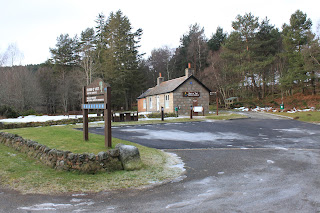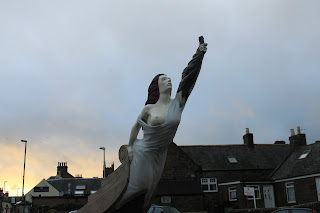We always know where we're going and what we're going to do before we set off, but we also try to leave as many options, as to the details of what we're going to do once we get there, open as possible. In this case we had decided during the week that we would go to Glen Dye but it would depend on the weather and how we were feeling as to what we would do once we got there. I'm explaining all this because this turned into a much longer, and more strenuous, walk than perhaps we envisaged. When we go to Glen Dye we park at the bridge over the Spital Burn, which is a tributary of the Water of Dye, about 6 miles from the village of Strachan (pronounced Stra-an), on the Cairn o' Mounth road. My guidebook tells me that the term Spital refers to a hospice that once stood on the site and goes on to say that it later became a notorious public house "a haunt of thieves and robbers". But all that's left now is an old ruined cottage.
We set off from the car at 09.30, which is quite early for us, and the temperature was (-)3. It was cloudy but crisp and the weather forecast was for a "getting better" kind of a day. We were just about to set off when a group of about a dozen men appeared, all well equipped and looking very purposeful. It was only after we had left the car and came across their vehicles that we realised they were from the RAF and Braemar Mountain Rescue units and were probably on an exercise of some kind. Leaving the road we walked down the track, crossing the Water of Dye just beyond a high fence and locked gate. The style here is as awkward as styles get but was nothing compared to the other adventures to come. In the past I've always photographed Clachnaben from the bridge but today it was shrouded in mist. Still the weather forecast promised better.
Just after the bridge we turned left and headed up the glen, generally following the Water of Dye upstream. The wooded area on the other side of the river gives way to moorland and heather as we followed the track further into the glen. The basic walk we had planned for the day was to walk into the Charr Bothy along the low track then back over the high track to make a circular route. The problem with this plan was mainly to do with time. If we did the basic walk we could be back at the car in under two hours. We chatted about this as we walked in and decided that we would add something on, but that we'd leave off making the decision until after we'd had our coffee at the bothy.
About halfway to the bothy, though a gap in the hills, we got our first glimpse of Clachnaben, still with a light covering of mist but, as the weather forecasters promised, it looked to be clearing. Also at this point there's evidence of habitation, with lots of crumbling stane dykes and what looks like a ruined cottage. There's also a great solitary pine tree that gives the impression of having been there forever. There is a local legend that a notorious warlock by the name of Colin Massie lived in Glen Dye, in a cottage where the lone tree stood, with his mother and brother, (although I must confess that a notorious warlock called Colin living with his Mum doesn't sound all that notorious). Anyway whether this is the spot or not I'm not sure but I still think the tree is great!
Shortly after the lone pine we came to one of these strange man-made things that you come across from time to time out in the middle of nowhere. In this case it's a small Scottish Water reservoir but I have no idea what or where the reservoir serves. The one notable thing about it though is the sign that tells us that it's the Glen Dye Raw Water Reservoir. I just love the term Raw Water!!
From the reservoir it's only a short walk to the Charr Bothy. I must say that I've never stayed overnight in a bothy but if it ever became a necessity I'd like to stay in one like this. The buildings were donated by the Fasque Estates to the Mountain Bothies Association, (MBA), with funding provided by the family and friends of the late John Whitley. We made ourselves comfortable and had a coffee and some chocolate of course, while we decided what we wanted to do next. The bothy sits on a crossroads where the Water of Charr joins the water of Dye, so from where we had come from we had three choices. Left would take us up into the hills, eventually joining the road again at the top of the Cairn o' Mounth; straight ahead leads, if you walk far enough, to Glen Esk or can also be used as a route to Mount Battock, the 778m high Corbett at the head of the glen; and right would take us up over a couple of small tops before coming to a junction where we could go to Clachnaben or if we were to carry on we would meet up with the Mount Battock route.
In the end we decided it was time to put a bit of effort into our walking after the last couple of weeks of coastal walks with tea and cake, so we headed up towards Clachnaben. Now I know what you're thinking; these two tops and even Clachnaben are not particularly high, but you need to remember that we haven't climbed anything higher than the stairs for the last 18 months, so any uphill effort was going to get the heart pumping. So with a steady plod we set off up towards the first of our little tops, the Cairn on Finglenny at 469 metres. The path wound its way up and for the first time we began to get patches of snow underfoot. The cairn itself meant that we had to leave the main path, but it was worth it for the views back to where we'd come from and across to the now clear Clachnaben.
From the cairn there was a flat then downhill section before we began another uphill slog towards the second of the tops, Hill of Edendocher at 577 metres. This section seen us walking on snow for a good bit of the way but this was no real problem since it was hard-packed and gave good grip. Looking down through some of the holes it was amazing how deep it still was and did leave us a wee bit wary of walking too close to the edges of the path just in case. The top at Hill of Edendocher was a bit indistinct apart from the granite outcrop a little way off the path and what looks to all intents and purposes a car parking area! However it did give some good views over to the snow covered Mount Battock.
From here it's only a short flat walk to the turn off to Clachnaben and the next decision we needed to take. In the end it wasn't really a difficult decision since it was now around one thirty and it seemed sensible to start making our way back to the car rather than walking further away from it. The downside of this decision of course is that we now had another stiffish climb up to the top, and the concern about what the path down from the top might be like.
Clachnaben is giant granite tor that can be seen from most places on Lower Deeside. At its tallest its cliffs are 29m high but there is relatively easy access up to the top from the west side. On the O & S map there are two heights shown - 579 and 589 metres - and I assume the lower height is the trig point and the higher the top of the tor. As we approached the top we saw a couple of people on the top and these were the first, apart from the mountain rescue people before we set off, that we had seen all day.
Despite the relatively easy scramble to the top of the tor, I was a wee bit reluctant because of the snow underfoot but Mo was for none of it so we clambered and slipped and cursed our way up and I must say the views are spectacular.
My fears as to the condition of the path down from the top were only partially borne out in that it was really icy near the top but as we dropped down it became more and more secure underfoot. It's worth mentioning here the great work done by the Clachnaben Path Trust who built and now maintain the path. It's easy underfoot with good solid steps where needed. We were just beginning to feel really pleased with ourselves when we came to a steep area where the snow covered the path for about 50 metres.
People had obviously passed this way before because there were plenty of footprints chipped out of the hard-packed snow but it was still quite exciting traversing the hill before making our way down through the heather to the path. From here it was a pleasant walk down through the forest with some nice views of Clachnaben against a sky that was now quite blue. So the weather forecasters got it right.
We stopped for a while where we exited from the trees at a nice seat in memory of one Heidi Jane Fish who died aged only 17. I have no idea who the young lady was or why she died so young, but her family picked a nice spot for her seat. From this spot it's a long flat walk back to the car and as ever when you know you're nearly finished, we were beginning to feel very tired as we re-crossed the Water of Dye and the dodgy style. I did however take time out to take one last photo of where we'd been.
So that was the end of a long, tiring but ultimately, satisfying day. We left the car at 09.30 and arrived back at 16.30.
Just a quick mention of the Robert Smith Guidebook 25 Walks on Deeside for his story about the hospice / public house and Colin the Warlock of Glen Dye.
J





















































